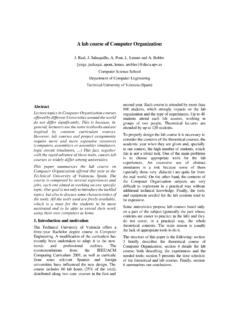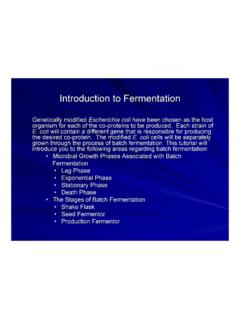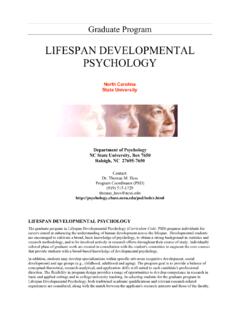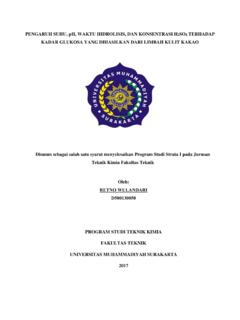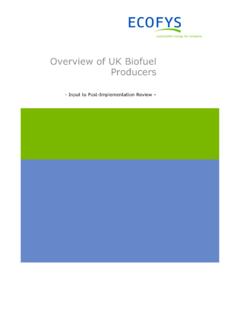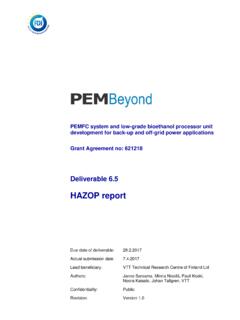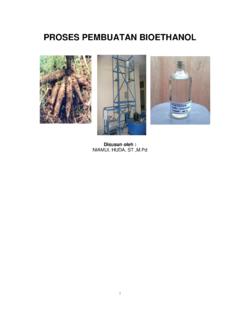Transcription of Bioreactors and Fermentation - NCSU
1 Bioreactors and FermentationOutline Terminology Bioprocess, bioprocessing, biochemistry, biotechnology, bioengineering, biomedical engineering, biophysics Biopharmaceutical, biofuel, biodiesel, bioethanol , E10, E85, B20, biomass, substrate, reaction kinetics, catalyst, enzyme Yeast Fermentation Bioreactor Analysis equipment Hemacytometer, Spectrophotometer, Cellometer, HPLC systemTerminology Bioprocess Any process that uses living cells or their components ( , bacteria, enzymes, chloroplasts) to obtain desired products Bioprocessing R&D and manufacturing of products prepared from or used by biological systems (food, feed, biopharmaceuticals, and cosmetics) Biochemistry Study of chemistry and biological processes of living organisms and the molecular basis for the changes occurring in living cells Biotechnology Use of biological systems to make/modify products/processes (plant regeneration, gene manipulation/transfer).
2 In the past, producers used cross-hybridization to alter a plant's genetic makeup. With biotechnology, DNA can be altered (contd.) Bioengineering Application of engineering in biological sciences. Bioprocess engin. (biocatalysis, bioseparation, bioinformatics, bioenergy), genetic engin. (sub-set of biotechnology), cellular engin. (tissue culture), and biomedical engin. are sub-sets of bioengineering. Biomedical engineering It combines chemical, electrical, and mechanical engineering to improve medical diagnosis (ultrasound, MRI), monitoring, and therapy (artificial hips, knees and other joints). Sometimes, biomedical engineering is also referred to as bioengineering.
3 Biophysics Use of physics to study biological systems. Overlaps with biochem., nanotechnology, bioengin., agrophysics. May involve molecular level issues (DNA, RNA, microscopy), structural biology, enzyme kinetics etc. Biomedical physics is a (contd.) Biopharmaceutical Medical drugs produced using biotechnology. They are proteins (including antibodies), nucleic acids (DNA, RNA or antisense oligonucleotides), recombinant vaccines, and monoclonal antibodies used for therapeutic or in vivo diagnostic purposes, and are produced by means other than direct extraction from a native (non-engineered) biological source.
4 Biofuel Solid, liquid or gaseous fuel derived from organic (relatively recently dead biological matter) material and is distinguished from fossil fuels, which are derived from long dead biological material. They can be produced from any (biological) carbon source, with the most common source being photosynthetic (contd.) Biodiesel (Fatty acid alkyl ester) Biofuel produced from vegetable oils (corn, cotton, rapeseed, soybean, palm, mustard), restaurant waste oils, animal fats or algae A non-petroleum-based diesel fuel consisting of long chain alkyl (methyl, propyl or ethyl) esters, made by transesterification of vegetable oil or animal fat (tallow), which can be used (alone, or blended with conventional petrodiesel) in unmodified diesel-engine vehicles (resulting in better emissions in the form of decreased particulates, CO, and hydrocarbons)
5 100 lbs of oil + 10 lbs of methanol > 100 lbs of biodiesel + 10 lbs of glycerol bioethanol An alcohol made by fermenting sugars from biological materials (starch crops -- corn) or cellulosic biomass (trees, grasses) Can be used as vehicle fuel in its pure form or as a gasoline additive to increase octane & improve vehicle emissions (CO2)Terminology (contd.) E10 Fuel that contains 10% ethanol, mixed with 90% gasoline E85 A mixture of 85% ethanol and 15% gasoline. This will not work in most cars. B20 A blend of 20% biodiesel and 80% petroleum diesel Biomass Biological material (C, H, O, N, alkali, alkaline earth, heavy metals) derived from living, or recently living organisms (plant or animal based)Terminology (contd.)
6 Substrate The surface a plant or animal lives upon (serves as food source for cells). It can be biotic or abiotic (non-living) materials. Reaction (chemical) kinetics Mechanism and factors influencing the speed of chemical reactions Catalyst A substance that increases the rate of a chemical reaction (by providing a lower activation energy reaction mechanism to occur) without being consumed or produced by the reaction. Proteins that act as catalysts in biochemical reactions are called enzymes. Enzyme A specialized chemical that helps living organisms perform a task. In Bioreactors , enzymes created by microorganisms attack the plant cell wall and break it up to get the glucose Unicellular fungus (more than 1000 species identified) Commonly used to leaven bread and ferment alcoholic beverages Most yeasts belong to the division Ascomycota A few yeasts (eg.)
7 , Candida albicans) can cause infection in humans Saccharomyces cerevisiae (most commonly used yeast), was domesticated for wine, bread, and beer production 2000+ yrs ago Yeast physiology can be either obligately aerobic or facultatively anaerobic (fermentative) There is no known obligately anaerobic yeast In absence of O2, fermentative yeasts produce energy by converting sugars into carbon dioxide and ethanol (alcohol) In brewing, ethanol is the desired product, while in baking, carbon dioxide raises the bread and the ethanol evaporatesYeast (contd.) Many yeasts can be isolated from sugar-rich environmental samples such as fruits and berries (grapes, apples, peaches etc.
8 And exudates from plants (such as plant saps or cacti) The most common mode of vegetative growth in yeast is the asexual reproduction by budding or fission A small bud (daughter cell), is formed on the parent cell The nucleus of the parent cell splits into a daughter nucleus and migrates into the daughter cell The bud continues to grow until it separates from the parent cell, forming a new cellYeast (contd.) In brewing beer, top-fermenting yeasts (float to the top of the beer) produce higher alcohol concentrations and prefer higher temperatures (15-25 C) Eg., Saccharomyces cerevisiae (known to brewers as ale yeast) They produce fruitier, sweeter type ale beers Bottom-fermenting yeasts ferment more sugars, leaving a crisper taste and work well at low temperatures (5-10 C) Eg.
9 , Saccharomyces uvarum (formerly known as Saccharomyces) carlsbergensis They are used in producing lager-type beers Brewers of wheat beers often use varieties of TorulasporadelbrueckiiFermentation Conversion of carbohydrate (eg. sugar) into acid or alcohol by yeast or bacteria It is used in brewing and wine making for the conversion of sugars to alcohol (ethanol CH3CH2OH) This process, followed by distillation, can be used to obtain pure ethanol ( bioethanol ) for use as a transport biofuel It can also be viewed as the energy-yielding anaerobic metabolic breakdown (respiration) of a nutrient molecule such as glucose, without net oxidation (eg.)
10 , in muscle cells) Fermentation typically refers to the Fermentation of sugar to alcohol using yeast, but other Fermentation processes include making of yogurt, souring of milk, rising of doughBioreactor An apparatus (usually jacketed cylindrical SS vessel) for growing organisms such as bacteria, viruses, or yeast that are used in the production of pharmaceuticals, antibodies, or vaccines, or for the bioconversion of organic wastes Under optimum conditions of gas (air, oxygen, nitrogen, and carbon dioxide) flow rates, temperature, pH, dissolved oxygen level, and agitation speed, the microorganisms or cells will reproduce at a rapid rateBioreactorControlsTemperaturePressur epHAgitation speedAir flow rateHemacytometerA device used to count cellsA thick glass microscope slide with a rectangular indentation that creates a chamber that is engraved with a laser-etched grid of perpendicular lines.
